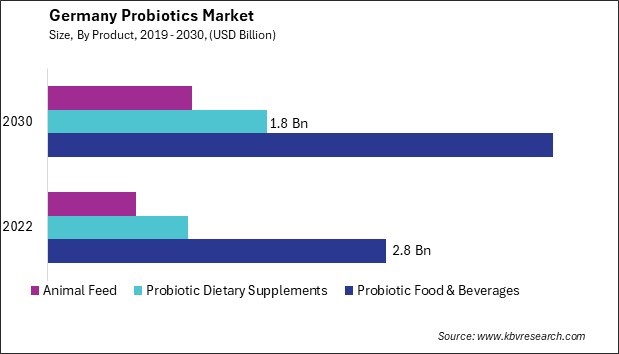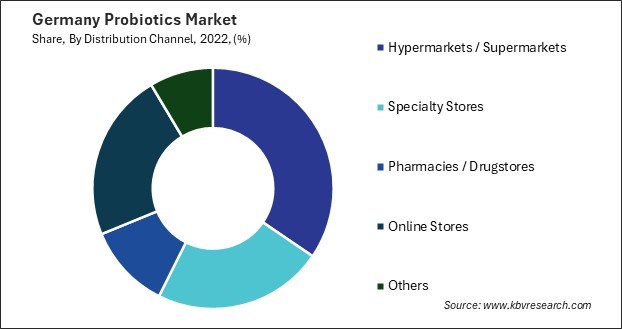Int'l : +1(646) 832-2886 | query@kbvresearch.com
Int'l : +1(646) 832-2886 | query@kbvresearch.com
Published Date : 16-May-2024 |
Pages: 103 |
Formats: PDF |
The Germany Probiotics Market size is expected to reach $7.2 Billion by 2030, rising at a market growth of 5.6% CAGR during the forecast period.
In Germany, the probiotics market has witnessed a surge in demand for products that promote digestive health, immune function, and overall well-being. This has been fueled by a growing interest in natural and holistic approaches to health, with consumers seeking products that support their health goals without compromising safety or efficacy. Probiotics have emerged as a popular choice among consumers looking for natural solutions to support their digestive and immune health.

Moreover, the Germany probiotics market has seen significant innovation and product development, with companies introducing a wide range of probiotic products tailored to consumer needs and preferences. These products include probiotic supplements, fermented dairy products, functional foods, and beverages, offering consumers various options to incorporate probiotics into their daily diet.
Furthermore, the COVID-19 pandemic has further accelerated the demand for probiotics in Germany, as consumers have become increasingly focused on maintaining their immune health. Probiotics are known for their potential to support immune function through their effects on gut health, making them an attractive choice for consumers looking to enhance their overall well-being during these challenging times.
Additionally, favorable regulatory frameworks and standards for probiotic products have supported the Germany probiotics market, ensuring product safety and quality for consumers. This has helped build consumer trust in probiotic products and has contributed to the market's growth and stability. Owing to continuous innovation, product development, and an increasing focus on health and wellness, it is anticipated that the market will sustain its upward trend, presenting prospects for both established entities and new entrants in the probiotic industry.
Probiotics derived from yeast, specifically those comprising Saccharomyces boulardii, have garnered considerable attention owing to their distinctive characteristics and capacity to bolster immune function and digestive health. The increasing market demand for probiotics derived from yeast can be attributed, in large part, to their efficacy in treating digestive disorders. Saccharomyces boulardii, a well-known yeast probiotic strain, has been extensively studied for its ability to promote gastrointestinal health by modulating the gut microbiota, reducing inflammation, and enhancing the integrity of the intestinal barrier. These properties make it a preferred choice for individuals seeking natural solutions for digestive discomfort and maintaining a healthy gut.
Moreover, yeast-based probiotics are known for their stability and resilience, particularly in challenging environments such as the acidic conditions of the stomach. The ability of probiotics derived from yeast to endure the digestive process and enter the intestines viable enables them to impart their advantageous impacts on gut health. The aforementioned attribute has played a role in the widespread acceptance of probiotics derived from yeast as a dependable alternative for promoting digestive health.
Furthermore, the versatility of yeast-based probiotics has led to their inclusion in a wide range of products, including dietary supplements, functional foods, and beverages. This diverse availability has made it easier for consumers in Germany to incorporate yeast-based probiotics into their daily routines, contributing to the increasing demand for these products.
Additionally, the growing body of scientific research supporting the health benefits of yeast-based probiotics has further fueled their demand in Germany. Studies have demonstrated the potential of Saccharomyces boulardii and other yeast strains to support immune function, reduce the risk of antibiotic-associated diarrhea, and alleviate symptoms of various digestive disorders, leading to greater consumer confidence in their efficacy. Hence, all these factors will aid in the growth of the market.
Probiotics, particularly Bifidobacterium and Lactobacillus, are increasingly recognized for their potential to support infant gut health and immune development, making them a desirable addition to infant formula products. Research has shown that the early establishment of a healthy gut microbiota during infancy can profoundly impact immune function, digestive health, and even cognitive development. Probiotics are believed to play a crucial role in this process by promoting the growth of beneficial gut bacteria and modulating the infant's immune system.
Furthermore, the aspiration of guardians to ensure that their infants receive optimal nutrition has generated a market demand for infant formula items that closely resemble the composition of human breast milk. Breast milk naturally contains diverse beneficial microorganisms, including probiotics, which contribute to the infant's developing immune system and overall health. Probiotic-fortified infant formulas aim to replicate this aspect of breast milk, offering a potential alternative for infants not exclusively breastfed.
Furthermore, the regulatory environment in Germany has played a role in driving the demand for probiotics in infant formula. The country has strict regulations governing infant nutrition, including requirements for the safety and efficacy of ingredients used in infant formula. Probiotics that satisfy these rigorous criteria are positively received by both consumers and healthcare practitioners, which has led to their growing integration into infant formula products.
Additionally, in recent years, there has been a substantial increase in the scientific evidence supporting the nutritional benefits of probiotics for infants, which has increased the demand for infant formula fortified with probiotics. Probiotics have been shown in studies to potentially mitigate the risk of specific infant health conditions, including allergies and eczema, while also enhancing digestive comfort and general well-being. This further supports their attractiveness to parents who are interested in providing their children with optimal nutrition. Therefore, as consumer interest in natural and functional infant nutrition continues to rise, probiotic-fortified infant formula is likely to remain a significant segment of the infant nutrition sector in Germany.

In the Germany probiotics market, several companies provide a wide range of probiotic products and solutions catering to various consumer needs and preferences. These companies are known for their expertise in probiotics, research and development efforts, and commitment to offering high-quality, science-backed products.
One prominent player in the Germany probiotics market is Chr. Hansen Holding A/S is a global bioscience company specializing in natural ingredient solutions for the food, nutritional, pharmaceutical, and agricultural industries. Chr. Hansen offers a diverse portfolio of probiotic strains and blends used in various applications, including dietary supplements, dairy products, and infant nutrition, addressing the growing demand for probiotics in the German market.
Another significant player is DuPont Nutrition & Biosciences. This DuPont de Nemours, Inc. division focuses on providing sustainable, bio-based ingredients and solutions for various industries, including food, beverage, dietary supplements, and animal nutrition. DuPont offers a range of probiotic products under its HOWARU® brand, targeting different health areas such as digestive health, immune support, and women's health, catering to German consumers' diverse needs.
Additionally, companies like Nestlé Health Science, a subsidiary of Nestlé S.A., are notable players in the Germany probiotics market, offering a range of probiotic products under various brands to promote digestive health and overall well-being. Nestlé Health Science leverages its expertise in nutritional science to develop probiotic solutions that address specific health needs, aligning with the growing demand for personalized nutrition options in Germany.
Other key companies operating in the Germany probiotics market include Danone, a multinational food-products corporation known for its probiotic yogurt and dairy products under brands like Activia®, and Yakult Honsha Co., Ltd., a Japanese probiotic dairy product manufacturer that has a presence in the German market with its probiotic drink, Yakult®, known for its digestive health benefits.
In summary, the Germany probiotics market is comprised of a number of significant participants who provide an extensive selection of probiotic goods and services to satisfy the increasing interest of consumers in health and wellness products. These companies are known for their commitment to research and innovation, product quality, and consumer satisfaction, driving the growth and development of the probiotics market in Germany.
By Ingredient
By Product
By End-use
By Distribution Channel